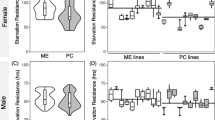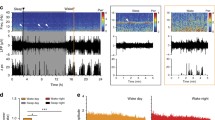Abstract
Sleep is conserved in the animal kingdom and plays a pivotal role in the adaptation of species. Sleep in Drosophila melanogaster is defined as any continuous 5 min of quiescence, shows a prominent siesta, and consolidated nighttime sleep. Here, we analyzed the sleep of two other species D. malerkotliana (DMK) and D. ananassae (DA), and compared it with D. melanogaster (DM). The DMK males and females have siesta like DM. However, unlike DM, flies continue to sleep beyond siesta till the evening. DA has a less prominent siesta compared to DM and DMK. In the morning, DA took a longer time to respond to the lights ON and continued to sleep for at least half an hour. The nighttime sleep of the DA flies is higher than the other two species. Average length of sleep episode is three times more than that of DM and DMK with few wake episodes. Thus, the nighttime sleep of DA males and females is deep and needs exposure to more potent stimuli to wake up relative to the other two species. DA males and females show higher sleep rebound than the other two species, suggesting the robustness of sleep homeostasis. Although total sleep of DMK and DA is similar, DA is a day-active species with highly consolidated night sleep. DMK, like DM, is a crepuscular species with a midday siesta. Thus, our results suggest that temporal partitioning of sleep, in sympatric species may contribute to temporal segregation.






Similar content being viewed by others
References
Agosto J, Choi JC, Parisky KM, Stilwell G, Rosbash M, Griffith LC (2008) Modulation of GABAA receptor desensitization uncouples sleep onset and maintenance in Drosophila. Nat Neurosci 11(3):354–359. https://doi.org/10.1038/nn2046
Allada R, Siegel JM (2008) Unearthing the phylogenetic roots of sleep. Curr Biol 18(15):R670–R679. https://doi.org/10.1016/j.cub.2008.06.033
Andretic R, van Swinderen B, Greenspan RJ (2005) Dopaminergic modulation of arousal in Drosophila. Curr Biol 15(13):1165–1175. https://doi.org/10.1016/j.cub.2005.05.025
Bahn JH, Lee G, Park JH (2009) Comparative analysis of Pdf-mediated circadian behaviors between Drosophila melanogaster and D. virilis. Genetics 181(3):965–975. https://doi.org/10.1534/genetics.108.099069
Bock I, Parsons PJ (1978) Australian endemic Drosophila V. Queensland rain-forest species associated with fungi, with descriptions of six new species and a rediscription of D. pictipennis Kertesz. Aust J Zool 26(2):331–347
Borbély AA (1982) A two process model of sleep regulation. Hum Neurobiol 1(3):195–204
Borbély AA, Daan S, Wirz-Justice A, Deboer TJ (2016) The two-process model of sleep regulation: a reappraisal. J Sleep Res 25(2):131–143. https://doi.org/10.1111/jsr.12371
Bushey D, Cirelli C (2011) From genetics to structure to function: exploring sleep in Drosophila. Int Rev Neurobiol 99:213–244. https://doi.org/10.1016/B978-0-12-387003-2.00009-4
Campbell SS, Tobler I (1984) Animal sleep: a review of sleep duration across phylogeny. Neurosci Biobehav Rev 8(3):269–300. https://doi.org/10.1016/0149-7634(84)90054-x
Cirelli C (2012) Brain plasticity, sleep and aging. Gerontology 58(5):441–445. https://doi.org/10.1159/000336149
Cirelli C, Tononi G (2008) Is sleep essential? PLoS Biol 6(8):216. https://doi.org/10.1371/journal.pbio.0060216
Das A, Mohanty S, Stephan W (2004) Inferring the population structure and demography of Drosophila ananassae from multilocus data. Genetics 168(4):1975–1985. https://doi.org/10.1534/genetics.104.031567
David JR (1981) Cosmopolitan, subcosmopolitan and widespread species: different strategies within the Drosophilid family (Diptera). Comptes Rendus De La Société De Biogéographie 57:11–26
David JR, Capy P (1988) Genetic variation of Drosophila melanogaster natural populations. Trends Genet 4(4):106–111. https://doi.org/10.1016/0168-9525(88)90098-4
Dobzhansky T, Dreyfus A (1943) Chromosomal aberrations in Brazilian Drosophila ananassae. Proc Natl Acad Sci USA 29(10):301–305. https://doi.org/10.1073/pnas.29.10.301
Donlea J, Leahy A, Thimgan MS, Suzuki Y, Hughson BN, Sokolowski MB, Shaw PJ (2012) Foraging alters resilience/vulnerability to sleep disruption and starvation in Drosophila. Proc Natl Acad Sci USA 109(7):2613–2618. https://doi.org/10.1073/pnas.1112623109
Geissmann Q, Beckwith EJ, Gilestro GF (2019) Most sleep does not serve a vital function: evidence from Drosophila melanogaster. Sci Adv 5(2):eaau9253. https://doi.org/10.1126/sciadv.aau9253
Graves L, Pack A, Abel T (2001) Sleep and memory: a molecular perspective. Trends Neurosci 24(4):237–243. https://doi.org/10.1016/s0166-2236(00)01744-6
Grima B, Chelot E, Xia R, Rouyer F (2004) Morning and evening peaks of activity rely on different clock neurons of the Drosophila brain. Nature 431(7010):869–873. https://doi.org/10.1038/nature02935
Guruprasad B, Padmaja CJ (2016) Drosophila: a model organism for assessment of biodiversity. J Entomol Zool Stud 4:88–90
Helfrich-Förster C (2018) Sleep in insects. Annu Rev Entomol 63:69–86
Hendricks JC, Finn SM, Panckeri KA, Chavkin J, Williams JA, Sehgal A, Pack AI (2000) Rest in Drosophila is a sleep-like state. Neuron 25(1):129–138. https://doi.org/10.1016/S0896-6273(00)80877-6
Hermann C, Saccon R, Senthilan PR, Domnik L, Dircksen H, Yoshii T, Helfrich-Forster C (2013) The circadian clock network in the brain of different Drosophila species. J Comp Neurol 521(2):367–388. https://doi.org/10.1002/cne.23178
Huber R, Ghilardi MF, Massimini M, Tononi G (2004) Local sleep and learning. Nature 430(6995):78–81. https://doi.org/10.1038/nature02663
Kauranen H, Menegazzi P, Costa R, Helfrich-Forster C, Kankainen A, Hoikkala A (2012) Flies in the north: locomotor behavior and clock neuron organization of Drosophila montana. J Biol Rhythms 27(5):377–387. https://doi.org/10.1177/0748730412455916
Kauranen H, Ala-Honkola O, Kankare M, Hoikkala A (2016) Circadian clock of Drosophila montana is adapted to high variation in summer day lengths and temperatures prevailing at high latitudes. J Insect Physiol 89:9–18. https://doi.org/10.1016/j.jinsphys.2016.03.005
Kopp A, Barmina O (2005) Evolutionary history of the Drosophila bipectinata species complex. Genet Res 85(1):23–46. https://doi.org/10.1017/s0016672305007317
Kume K, Kume S, Park SK, Hirsh J, Jackson FR (2005) Dopamine is a regulator of arousal in the fruit fly. J Neurosci 25(32):7377–7384. https://doi.org/10.1523/JNEUROSCI.2048-05.2005
Manjunatha T, Hari Dass S, Sharma VK (2008) Egg-laying rhythm in Drosophila melanogaster. J Genet 87(5):495–504. https://doi.org/10.1007/s12041-008-0072-9
McNamara P (2019) The neuroscience of sleep and dreams. Cambridge University Press, Cambridge
Menegazzi P, Dalla Benetta E, Beauchamp M, Schlichting M, Steffan-Dewenter I, Helfrich-Forster C (2017) adaptation of circadian neuronal network to photoperiod in high-latitude European drosophilids. Curr Biol 27(6):833–839. https://doi.org/10.1016/j.cub.2017.01.036
Nath RD, Bedbrook CN, Abrams MJ, Basinger T, Bois JS, Prober DA, Sternberg PW, Gradinaru V, Goentoro L (2017) The jellyfish Cassiopea exhibits a sleep-like state. Curr Biol 27(19):2984–2990. https://doi.org/10.1016/j.cub.2017.08.014
O’Grady PM, DeSalle R (2018) Phylogeny of the genus Drosophila. Genetics 209(1):1–25
Parshad R, Paika I (1964) Drosophilid survey of India. II. Taxonomy and cytology of the subgenus Sophophora (Drosophila). Res Bull Punjab Univ 15:225–252
Potdar S, Sheeba V (2013) Lessons from sleeping flies: insights from Drosophila melanogaster on the neuronal circuitry and importance of sleep. J Neurogenet 27(1–2):23–42. https://doi.org/10.3109/01677063.2013.791692
Prabhakaran PM, Sheeba V (2012) Sympatric Drosophilid species melanogaster and ananassae differ in temporal patterns of activity. J Biol Rhythms 27(5):365–376. https://doi.org/10.1177/0748730412458661
Prabhakaran PM, Sheeba V (2013) Insights into differential activity patterns of drosophilids under semi-natural conditions. J Exp Biol 216(Pt 24):4691–4702. https://doi.org/10.1242/jeb.092270
Prabhakaran PM, Sheeba V (2014) Temperature sensitivity of circadian clocks is conserved across Drosophila species melanogaster, malerkotliana and ananassae. Chronobiol Int 31(9):1008–1016. https://doi.org/10.3109/07420528.2014.941471
Prabhakaran PM, De J, Sheeba V (2013) Natural conditions override differences in emergence rhythm among closely related drosophilids. PLoS ONE 8(12):e83048. https://doi.org/10.1371/journal.pone.0083048
Rechtschaffen A, Gilliland MA, Bergmann BM, Winter JB (1983) Physiological correlates of prolonged sleep deprivation in rats. Science 221(4606):182–184. https://doi.org/10.1126/science.6857280
Rieger D, Fraunholz C, Popp J, Bichler D, Dittmann R, Helfrich-Forster C (2007) The fruit fly Drosophila melanogaster favors dim light and times its activity peaks to early dawn and late dusk. J Biol Rhythms 22(5):387–399. https://doi.org/10.1177/0748730407306198
Russo CAM, Mello B, Frazao A, Voloch CM (2013) Phylogenetic analysis and a time tree for a large drosophilid data set (Diptera: Drosophilidae). Zool J Linn Soc 169(4):765–775. https://doi.org/10.1111/zoj12062
Sehgal A, Mignot E (2011) Genetics of sleep and sleep disorders. Cell 146(2):194–207. https://doi.org/10.1016/j.cell.2011.07.004
Shang Y, Griffith LC, Rosbash M (2008) Light-arousal and circadian photoreception circuits intersect at the large PDF cells of the Drosophila brain. Proc Natl Acad Sci USA 105(50):19587–19594. https://doi.org/10.1073/pnas.0809577105
Shang Y, Donelson NC, Vecsey CG, Guo F, Rosbash M, Griffith LC (2013) Short neuropeptide F is a sleep-promoting inhibitory modulator. Neuron 80(1):171–183. https://doi.org/10.1016/j.neuron.2013.07.029
Shaw PJ, Cirelli C, Greenspan RJ, Tononi G (2000) Correlates of sleep and waking in Drosophila melanogaster. Science 287(5459):1834–1837. https://doi.org/10.1126/science.287.5459.1834
Shaw PJ, Tononi G, Greenspan RJ, Robinson DF (2002) Stress response genes protect against lethal effects of sleep deprivation in Drosophila. Nature 417(6886):287–291. https://doi.org/10.1038/417287a
Sheeba V, Sharma VK, Chandrashekaran MK, Joshi A (1999) Persistence of eclosion rhythm in Drosophila melanogaster after 600 generations in an aperiodic environment. Naturwissenschaften 86(9):448–449. https://doi.org/10.1007/s001140050651
Sheeba V, Fogle KJ, Kaneko M, Rashid S, Chou YT, Sharma VK, Holmes TC (2008) Large ventral lateral neurons modulate arousal and sleep in Drosophila. Curr Biol 18(20):1537–1545. https://doi.org/10.1016/j.cub.2008.08.033
Singh BN, Yadav JP (2015) Status of research on Drosophila ananassae at global level. J Genet 94(4):785–792. https://doi.org/10.1007/s12041-015-0577-y
Steriade M (2006) Grouping of brain rhythms in corticothalamic systems. Neuroscience 137(4):1087–1106. https://doi.org/10.1016/j.neuroscience.2005.10.029
Stoleru D, Peng Y, Agosto J, Rosbash M (2004) Coupled oscillators control morning and evening locomotor behaviour of Drosophila. Nature 431(7010):862–868. https://doi.org/10.1038/nature02926
Tabuchi M, Lone SR, Liu S, Liu Q, Zhang J, Spira AP, Wu MN (2015) Sleep interacts with aβ to modulate intrinsic neuronal excitability. Curr Biol 25(6):702–712. https://doi.org/10.1016/j.cub.2015.01.016
Tainton-Heap LAL, Kirszenblat LC, Notaras ET, Grabowska MJ, Jeans R, Feng K, Shaw PJ, van Swinderen B (2021) A paradoxical kind of sleep in Drosophila melanogaster. Curr Biol 31(3):578–590. https://doi.org/10.1016/j.cub.2020.10.081
Throckmorton LH (1975) The phylogeny, ecology and geography of Drosophila. Handb Genetics 3(17):422–469
Tobari Y (1993) Drosophila ananassae: genetical and biological aspects. Japan Science Socity Press, Tokyo
Tononi G, Cirelli C (2014) Sleep and the price of plasticity: from synaptic and cellular homeostasis to memory consolidation and integration. Neuron 81(1):12–34. https://doi.org/10.1016/j.neuron.2013.12.025
Vaccaro A, Dor YK, Nambara K, Pollina EA, Lin CD, Greenberg ME, Rogulja D (2020) Sleep loss can cause death through accumulation of reactive oxygen species in the gut. Cell 181(6):1307–1328. https://doi.org/10.1016/j.cell.2020.04.049
van Alphen B, Yap MH, Kirszenblat L, Kottler B, van Swinderen B (2013) A dynamic deep sleep stage in Drosophila. J Neurosci 33(16):6917–6927. https://doi.org/10.1523/JNEUROSCI.0061-13.2013
van Alphen B, Semenza ER, Yap M, van Swinderen B, Allada R (2021) A deep sleep stage in Drosophila with a functional role in waste clearance. Sci Adv. https://doi.org/10.1126/sciadv.abc2999
Venken KJ, Simpson JH, Bellen HJ (2011) Genetic manipulation of genes and cells in the nervous system of the fruit fly. Neuron 72(2):202–230. https://doi.org/10.1016/j.neuron.2011.09.021
Walker MP, Stickgold R (2004) Sleep-dependent learning and memory consolidation. Neuron 44(1):121–133. https://doi.org/10.1016/j.neuron.2004.08.031
Watanabe H, Fujisawa T, Holstein TW (2009) Cnidarians and the evolutionary origin of the nervous system. Dev Growth Differ 51(3):167–183. https://doi.org/10.1111/j.1440-169X.2009.01103
Xie L, Kang H, Xu Q, Chen MJ, Liao Y, Thiyagarajan M, O’Donnell J, Christensen DJ, Nicholson C, Iliff JJ, Takano T, Deane R, Nedergaard M (2013) Sleep drives metabolite clearance from the adult brain. Science 342(6156):373–377. https://doi.org/10.1126/science.1241224
Xu K, Zheng X, Sehgal A (2008) Regulation of feeding and metabolism by neuronal and peripheral clocks in Drosophila. Cell Metab 8(4):289–300. https://doi.org/10.1016/j.cmet.2008.09.006
Yang G, Lai CS, Cichon J, Ma L, Li W, Gan WB (2014) Sleep promotes branch-specific formation of dendritic spines after learning. Science 344(6188):1173–1178. https://doi.org/10.1126/science.1249098
Acknowledgements
We thank Sheeba Vasu for fly lines. We thank Science and Engineering Research board for Ramanujan fellowship (SB/S2/RJN-005/2016) and EMR/2017/001625 to SRL. We will also like to acknowledge CSIR for fellowship to Nisha Sharma and Sukriti Mishra. We thank Sheetal Potdar for reading our manuscript and some useful suggestions. We also thank three anonymous reviewers for useful suggestions.
Author information
Authors and Affiliations
Corresponding author
Additional information
Publisher's Note
Springer Nature remains neutral with regard to jurisdictional claims in published maps and institutional affiliations.
Supplementary Information
Below is the link to the electronic supplementary material.
Rights and permissions
Springer Nature or its licensor (e.g. a society or other partner) holds exclusive rights to this article under a publishing agreement with the author(s) or other rightsholder(s); author self-archiving of the accepted manuscript version of this article is solely governed by the terms of such publishing agreement and applicable law.
About this article
Cite this article
Mishra, S., Sharma, N., Singh, S.K. et al. Peculiar sleep features in sympatric species may contribute to the temporal segregation. J Comp Physiol B 193, 57–70 (2023). https://doi.org/10.1007/s00360-022-01463-4
Received:
Revised:
Accepted:
Published:
Issue Date:
DOI: https://doi.org/10.1007/s00360-022-01463-4




